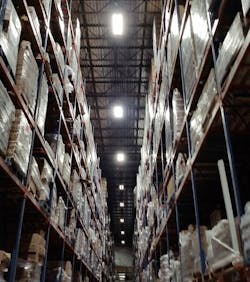By Northwest Lighting Network
The typical warehouse has areas with predictably high and low activity. However, many areas of a warehouse space have intermittent activity that is less predictable. Some warehouses also have daylighting through windows, skylights, and/or clerestories that provide an additional light source. Read on to find out how implementing an appropriate lighting controls solution that takes all of these aspects into account can translate into significant energy savings.
The solution
To ensure maximum benefit from any control measure, use modern luminaires with dimmable ballasts and drivers. Occupancy sensor deployment is the first and best control strategy to apply. This will capture the most savings from sparsely used areas. However, in areas with high activity time-based controls would suffice. If enough daylight is present, applying photosensors is a good option. Luminaire Level Lighting Controls (LLLCs) that combine occupancy, daylighting, and time clocks on a networked system can be a powerful tool to leverage continued savings (Table 1).
Design considerations
Good visibility is a key consideration when speed and accuracy are important. In a warehouse, most of the visual tasks are vertical (e.g., reading side labels on boxes), so attention needs to be given to high-angle lighting and glare control. Many warehouses have forklift and foot traffic; thus, safety is a concern. Modern lighting, particularly LED sources, can come to full brightness rapidly once sensors detect activity in the area. However, sensor placement is critical to ensuring that activity is detected properly. If controls are installed in each luminaire, the system will be responsive to changes in occupancy. Because of the high mounting heights often found in warehouses, use sensors that have a sufficient range to respond to foot traffic and a narrow enough detection pattern to limit false ON responses.
When LLLCs are combined with an advanced lighting control network, luminaires can be configured to turn ON in groups or zones, not only aiding in productivity and safety, but also increasing energy savings (Table 2). For example, when someone enters an aisle, the light nearest the activity is turned up to 100%. Lights in the immediate area will come on to 50%, while lights further away remain OFF, helping to add energy savings while improving contrast ratios.
With an LLLC solution deployed, the controls can adapt to a change in work flow or reconfiguring of the inventory. If you’re upgrading to new luminaires, see if the controls can be installed at the factory. This can ensure a more robust deployment/more reliable performance, and will reduce installation costs. When a layered control strategy is applied, daylight savings will be minimal in lightly occupied areas because occupancy sensors will have already turned the lights off.
Lessons in LED high bay lighting layouts
In a typical high, open ceiling warehouse application, it is possible to provide high-quality lighting that adequately illuminates the warehouse shelves while meeting or beating the local energy code. The situation requires luminaires with optical control capable of effectively distributing light onto the vertical surfaces. This provides excellent product recognition and improved productivity. Let’s take a look at some important design considerations and controls strategies you should factor into the lighting layout.
Install industrial LED high-bay luminaires centered within each aisle. Luminaires with narrow teardrop shaped optical distributions will provide reasonable uniformity on the vertical face of the shelves while pushing light all the way down to the floor.
The luminaires must be installed where the bottom of the fixture is at the same level or higher than the top of shelved product. The stack layout must correspond to the lighting layout to minimize shadows. Tall stacks have a large impact on the illumination of the space. Vertical surfaces absorb and block light.
Many jurisdictions require automatic OFF occupancy sensors in warehouses. Even if it is not required, occupancy control is an excellent strategy. See Table 3 for a few examples of how different jurisdictions follow different codes and lighting power allowances. Controlling each aisle independently is also a good energy-saving strategy. Mounting sensors on each luminaire can increase savings in spaces with long aisles. This is called luminaire level lighting controls and can simplify commissioning and increase the granularity of the control.
Sidebar: DOT Foods Lights Up Energy Savings
Dot Foods, the nation’s largest food industry redistributor, tackled the energy efficiency of its Burley, Idaho distribution center by investing in an LED lighting upgrade with occupancy controls. With technical support provided by its local electric utility, United Electric Cooperative, Dot Foods expects to save more than 216,000 kilowatt hours of electricity annually. In addition to reduced energy consumption and increased energy savings, Dot Foods’ Idaho facility has achieved another triumph: It was a recipient of the 2015 Idaho Awards for Leadership in Industrial Efficiency from the Idaho Office of Energy Resources.
“This facility operates around the clock, so reducing energy consumption has been a challenge,” said Mark Gratzer, maintenance manager, Dot Foods. “LED fixtures consume less power than our old metal halides and require less maintenance. We were constantly battling burned-out bulbs and ballasts with our old fixtures. Metal halides didn’t perform well in the event of short-duration power outages and could take 15 minutes to warm up, while the LEDs reach full brightness right away.”
In its most recent lighting upgrade, Dot Foods focused on the non-temperature controlled warehouse, truck garage, and machine room areas, which total approximately 70,000 square feet. They replaced 139 metal-halide luminaires (400W and 320W) with more efficient 229W and 167W LEDs. Integral occupancy sensor controls were installed on LED high bays in the warehouse, and programmed to turn lights off 10 seconds after someone leaves the aisle.
“The controls are an essential part of this project,” continued Gratzer. “We set them to dim to 10% when the area is not in use. If someone is picking up product on aisle 14, aisle 3 doesn’t need to be fully lit. In this case, we decided that light should follow the work.”
Cash incentives from United Electric helped reduce the cost of the project and deliver a payback period of less than 1.5 years.
“The incentives are vital to getting these projects approved,” explained Gratzer. If the utility can pay roughly half the cost of the project, that drives down the payback, and makes it a no-brainer type of decision.”







